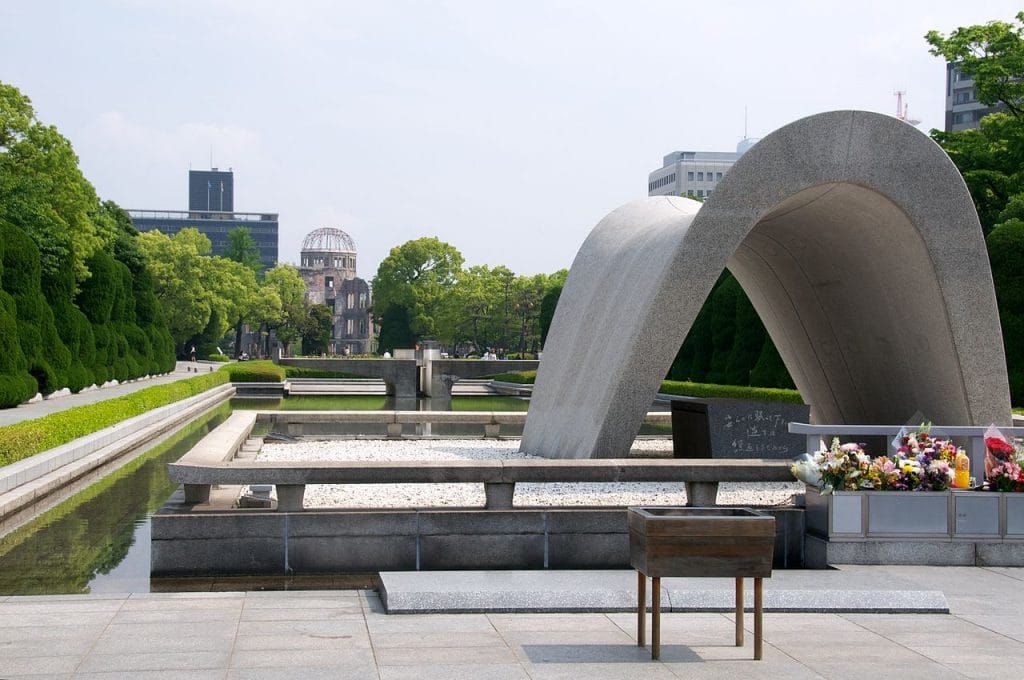The atomic bomb and common security
By Richard Rhodes | August 6, 2020
 The Memorial Cenotaph at Hiroshima Peace Memorial Park, 2012. Wikimedia Commons.
The Memorial Cenotaph at Hiroshima Peace Memorial Park, 2012. Wikimedia Commons.
Since the first use of nuclear weapons in war, 75 years ago this August, people concerned with the danger of large-scale nuclear war keep rediscovering a powerful tool for its prevention. If it were made of metal we would have built and deployed it long ago. It’s made instead of thought, and because thought has no permanence in and of itself, people keep forgetting it. But because thought is, or can be, insistent, urgent, compelling, they keep rediscovering it. Nor will it go away. It won’t go away because it’s the only answer to the threat of nuclear weapons that makes sense.
Niels Bohr, the great Danish physicist and philosopher, brought it with him when he arrived at Los Alamos, New Mexico, in December 1943, having escaped the Nazi invasion of Denmark and been briefed on the atomic project underway in England and the United States. Los Alamos was where the first atomic bombs were being designed and actually built.
Robert Oppenheimer, the American theoretical physicist who directed the invention of atomic bombs at Los Alamos during the war, and who then chaired the scientific advisory committee to the United States Atomic Energy Commission in 1949 that advised against the development of the hydrogen bomb, learned the answer from Bohr, and shared it with his fellow Americans in lectures and interviews postwar. He discussed it even before his country had begun amassing a vast nuclear arsenal and before other nations—Soviet Russia most of all—had acquired nuclear weapons as well.
The answer—the only answer to the clear and present danger of nuclear destruction—then somehow made its way in the 1970s through the murk of Cold War to the prime minister of Sweden. Olof Palme offered it as an alternative to national security, the kind of security that depends on accumulating more power than your enemies while doing everything you can to limit their accumulation of such power. Palme chaired a major United Nations commission in 1981 that presented the answer in depth.
And, finally, Soviet president Mikhail Gorbachev, having studied the Palme Commission report, carried the answer with him to Reykjavik, Iceland, to the historic 1986 summit meeting there with US President Ronald Reagan, where it informed a discussion that came within a hair’s breadth of an agreement between the two leaders to begin the process of abolishing all the nuclear weapons in the world.
What was this powerful answer? Niels Bohr, speaking to US President Franklin Roosevelt in the spring of 1944, when World War II was still raging in Europe and in the Pacific, framed it this way: “We are in an entirely new situation, that cannot be resolved by war.”
Robert Oppenheimer framed it this way, speaking to his comrades at Los Alamos a month after the end of World War II: “Atomic weapons are a peril which affects everyone in the world, and in that sense a completely common problem.”
Olof Palme, German chancellor Willy Brandt, and Brandt’s Bundestag adviser Egon Bahr framed the answer most succinctly. They called it “common security.” In Bahr’s words: “Security can now only be achieved in common. No longer against each other but only with each other shall we be secure.”
National security is based on the belief that nations can only make themselves more secure by making their adversaries less secure. That’s a formula for mutual insecurity—for arms races and the continuing threat of war.
In a world armed with nuclear weapons, it’s a formula that holds potential for the deaths of billions of human beings and the destruction of the human and natural world.
National security so-called is the present policy of the nuclear powers, the United States and Russia at the head of the line. The two countries between them maintain a total arsenal of 13,000 nuclear weapons. The other seven nuclear powers combined maintain another 1,200. Should those weapons ever be exploded, they would darken and freeze the earth with a nuclear winter equivalent or nearly so to the asteroid impact 66 million years ago that shrouded the world in smoke and darkness long enough to starve out more than 90 percent of all living species, including the dinosaurs that had dominated the world for the previous 60 million years.
Egon Bahr summarized the situation clearly in a post–Cold War review of the idea of common security:
Political and strategic thinking is still dominated by the concepts of the pre-nuclear age—security against the enemy, advantages over him, maybe even superiority in order to be able to win a war, should this become necessary. In other words, both the military and the politicians still consider conflict in terms of victory or defeat. [But] victory is no longer possible in the nuclear age…. We must instead strive for common security, that is, security together with, and not against, a potential enemy.
The idea of common security may seem vacuous against the cold brutality of nuclear weapons and their military and political champions. But when West Germany embodied the idea in policy in its relationship with the Soviet Union in the early 1980s and when Mikhail Gorbachev then carried it to Reykjavik, it contributed directly to the end of the Cold War, to the partial nuclear disarmament of the two superpowers, and to the subsequent reuniting of East and West Germany into a single nation again. Not a shot was fired.
The work of freeing the world from the threat of nuclear war, nuclear winter, and world-scale destruction must fall now to the young. Young citizens who have taken up the cause of limiting global warming need to realize that nuclear war is an equal and more immediate threat to human and natural life.
A form of common security is the answer to global warming, since the scale of the threat is international and common to all. What young citizens learn from their work against global warming they can apply to their work against nuclear weapons as well. The two strategies go together. And they are a challenge worthy of the young generation now moving toward authority in the world. No two challenges are greater. No two challenges promise such positive change toward a more prosperous and peaceful world.
“Security can now only be achieved in common. No longer against each other but only with each other shall we be secure.”
“We are in an entirely new situation, that cannot be resolved by war.”
Editor’s note: This essay was first published by the United Religions Initiative. It appears here with the permission of the author.
Together, we make the world safer.
The Bulletin elevates expert voices above the noise. But as an independent nonprofit organization, our operations depend on the support of readers like you. Help us continue to deliver quality journalism that holds leaders accountable. Your support of our work at any level is important. In return, we promise our coverage will be understandable, influential, vigilant, solution-oriented, and fair-minded. Together we can make a difference.
Keywords: Hiroshima and Nagasaki, global security, national security
Topics: Nuclear Risk
















I agree with Rhodes. I came to the same conclusion and have developed an argument for it in my most recent book titled Nuclear Ethics in the 21st Century: Survival, Order, Justice. I’m very happy to see the notion of common security re-entering the security discourse.
I too agree with Rhodes and Doyle. It would have been nice to see mention of the Russell-Einstein Manifesto (1955). It seems to me to have been crucial in bringing about a new thinking re the danger of nuclear weapons and the need for international cooperation to bring about common security and an end to the Cold War–which it did, but for too a short a time as is only too obvious today.